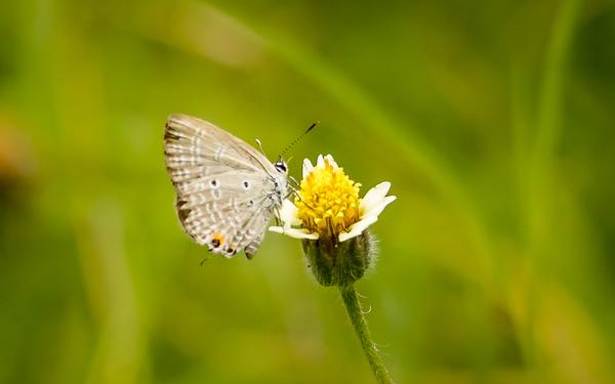Actor Mammootty, a keen photographer, recently shared a photograph of him clicking the birds around his home on Instagram. It is not just him; many keen photographers have been focussing on feathered visitors to their homes during the lockdown. For them it has been a discovery of the world in birds, flowers, raindrops, leaves, insects and the play of light and shadow. Although they are not professional photographers, these shutterbugs are taking a close look at their surroundings, at objects and living organisms that we take for granted in our daily lives.
In the case of Sneha Rajendra (@wander_doc), an emergency physician at SUT Hospital in Thiruvananthapuram, the spike in COVID-19 extended her work to 30-hour shifts. So the avid travel photographer has turned to observe her work environment with new eyes. “Usually after long shifts, I used to take off in my car for long drives and click snaps of people, food, culture and scenic sights. However, now it is my workplace and food that I zoom into,” she says. Her Instagram is filled with photographs of food photographs and the hospital environment.
Madhava Kurup M, Associate Professor at the Asian School of Business, (@mckurup), used to take pictures of birds, greenery and the landscape. During the lockdown, he felt miserable for a few days until he discovered the magical world around him, right at his home. “An inspirational TED talk by Dewitt Jones, a photographer with National Geographic, who talked about ‘celebrating what’s right with the world’ instead of getting drowned in the dismal news that is being bombarded on us, motivated me to look around in my vicinity.”
Using macro lens
Macro lens help them capture beautiful pictures of tiny flowers and insects, some of which are less than five millimetre. Madhav, architect TM Cyriac (@cyriactm) and biotechnologist Ayyappan R Nair (@ayyunair2) have been making the most of their macro lens to get up and close with residents and visitors in their gardens and neighbourhood.
Says Cyriac: “Lack of time was a huge limitation to learn new techniques. Now, I have the time to hone my photography skills and pick up new ones, all from YouTube videos. I am also putting those skills into practice. I was more into architecture and landscape. I bought a macro lens and began to focus on these tiny wayside flowers,” says Cyriac.
Agreeing with Cyriac, Ayyappan feels that being confined to a place can put pressure on a creative person. But then, one starts observing things differently, even minute things. “Honestly, I would not have noticed the butterflies had I not had the time. Now, I am learning their names, where they originate from, various things about these creatures.”
Madhav has been extensively using his macro lens to shoot flowers and butterflies. “I never realised that rain drops on a flower can create a flutter in my heart or the bee feasting on nectar, oblivious to the world around it, can look adorable,” he says.
For Cyriac, the breathtaking photos of flowers that he puts up on Instagram are not single snaps. He takes 10 to 15 shots, “stack them and use special techniques to accentuate their beauty”. He also started taking still life indoors with artificial lighting, an attempt at abstract photography. “I began to observe these tiny flowers during my daily walk. I made the effort to find out their names and that of insects too. I plan to start a website with these snaps I have taken. Instead of botanical illustrations, with the help of advanced photographic techniques, we can document the plant wealth of Kerala. I am thinking in that direction,” he explains.
Up-close with Nature
Sudha Bhuvanachandran, a homemaker, did not need the lockdown to enjoy the sights around her neighbourhood in Ottasekharmangalam, in the rural suburbs in Thiruvananthapuram. “The lockdown gave me a chance to see Nature at her best as pollution was relatively lesser. My innate eye for light and shadow may have helped me compose my photographs. When mobile phones with camera came on the scene, it triggered the photographer in me. I used to borrow my sons’ phone to take photographs of my surroundings and garden till I got my own camera five years ago,” says Sudha.
Nature is her muse. The photographs stayed in her computer and camera. When ‘Her Trivandrum’, a Facebook group was started, she posted some of her works. “I got a pleasant surprise when my snaps won a lot of appreciation. I am happy that my photographs are giving viewers so much joy,” says Sudha.
For Jincy Williams, a librarian (@jincy_photos), it is the pleasure she derives from showcasing Nature that motivates her to keep clicking. She waxes lyrical about the play of light on leaves and how they change through the day. Enhancing the beauty of the familiar and the neglected gives her a thrill.
Ayyappan finds photography therapeutic and peaceful. “At present, clicking them is the first thing I do every day in the morning and sometimes even at noon or in the evening. It has been a learning experience, about macro photography and about the natural world around us.” Post lockdown, he plans to continue his passion.
“In a way, this was a healing experience too — it was as though Nature was telling me that there is still beauty, tranquillity and hope. While I was grieving for those who were taken away by the pandemic, there was this assurance from Nature that ‘this too will pass’ and it helped me to be at peace, and appreciate all those ‘small’ things. For those of you who haven’t noticed it yet — every flower is different; every leaf has a different texture; and every droplet that hangs on is an act of courage that needs to be admired,” asserts Madhav.
Source: Read Full Article

